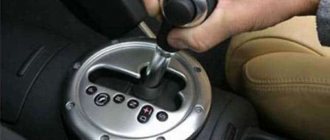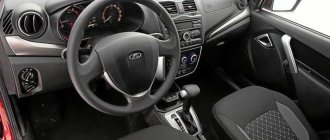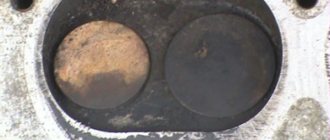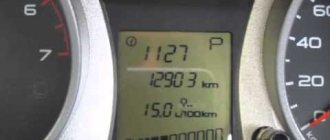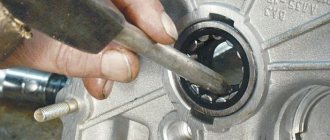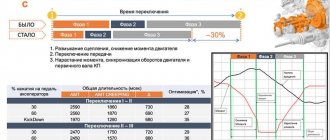How to skid on the spot? Using the example of mechanics and automatic transmission
Download PDF
Having a manual or automatic transmission installed, how to slip in place? Will this cause harm to units and components? We will answer these questions and more in this section. It is no secret that this nonsense affects mainly young and impulsive drivers (street racers) who do not know a lot about technology and the cost of breakdowns. As they say, the main thing is to put your slippers on the floor
.
In this way, guys try to stand out from the crowd in front of friends and colleagues, as well as attract the attention of girls. But what will follow such antics? In what condition will the car return home then? It’s good if it’s yours, not your father’s. Do you understand what I'm talking about. But there is another side to the coin...
"Crank" on "automatic"
It's not that simple here
as it seems to some. It is possible to slip only if the road is slippery: ice, snow, or, in extreme cases, sand on the beach. You can't do this on asphalt. They say that some people manage to make a crank in the “neutral” mode on an automatic transmission, but one hardly believes in such fables.
Let's simulate the situation:
stuck in a snowdrift and need to get out with an automatic transmission. To do this, engage the “R” gear, before doing this we squeeze the foot brake.
In this mode, we wait about 3 minutes until the oil is pumped up by the torque converter and gradually begin to release the brake, increasing the speed. High speeds will quickly damage the automatic transmission clutches. Minimal cooling may cause the liquid to boil.
In a word, slipping is allowed, but within moderate limits.
Therefore, if you really want to learn the art of drag racing, first take training courses at any driving school and only after that feel free to get behind the wheel of your car. Actually, they gave a full answer to the question: how to skid on the spot. Always make an informed decision.
Source
SvarogovMSK › Blog › Answer: How to grind on site? How to burn rubber? How to do Burnout.
Good health. I don’t know why today I received such questions as “How to grind on site?”, “How to burn rubber?”, “How to do Burnout?”
etc. I don’t understand why they started asking me such questions, but I feel it won’t end with 4 guys and that’s why I decided to quickly answer everyone at once.
You can sand everything, even Zil 124 (Yes, it happened, I was about 13 years old and I was acting up, calm down.)
. Do you have a weak car? Do you feel sorry for the tires? It's simple. In winter on snow it is easy and without much harm to the tires, but there will be no smoke. In summer you can create a lot, a lot of smoke and the secret is simple. Take engine oil, pour it onto the asphalt, add water so that there is a puddle and just stand on the drive wheels and grind it, there will be a lot of smoke from the oil, but don’t forget that then you need to wash the tires if you drive on them, so that you will The road didn't get carried away and didn't get into an accident. Try to use bald tires on light rims for the drive wheels; you can even buy a used one and polish it.
Next and the most important thing is how to do it. The easiest way is on a front-wheel drive car with manual transmission.
Stand on snow, a puddle, or the consistency mentioned above, lift the clutch and as the gas begins to move off, the handbrake and it will begin to grind. Some people simply drive their drive wheels up to the curb and grind against it.
Automatic front wheel drive
The same thing, you just need to set the L3 mode and turn off the traction control.
With rear wheel drive on mechanics
it’s more difficult, here you need to have the wheels spinning and you press the brakes, and since the rear brakes will grab, it’s difficult to do this on a weak car, the same check, you need to make a system that will block the front wheels, but not the rear ones, also without the system will cause the brakes to overheat, and the old ones also have drum brakes, which is generally crap.
You can read about this in other articles (Not mine, I won’t describe this.)
.
For powerful cars this is overheating of the brakes, but it is still real. You need to depress the clutch with your left, press the brake with your right heel, and press the gas with your toe. By the way, in the new Dodge Challenger Hellcat
there is a button that blocks the front brakes and you only need to press the gas. The system is not difficult to create.
Automatic, rear wheel drive
, this is the most difficult thing, unless of course you have a system like the
Dodge Challenger Hellcat
. There is a very high probability that your box will simply collapse, so I won’t advise you and you need to run.
There is also special rubber that has the color of smoke, but it is expensive.
And most importantly, there are advisers who tell you to unscrew the brake hoses, but they apparently don’t know that most cars have a parallel system, and when you unscrew one hose, it is responsible for the front left and rear right brakes, and the other is for the front right and rear left brake. So let’s say it’s X-shaped, so that if 1 hose breaks, for example, then you will have 2 wheels brake on opposite sides, and not pull you to the side.
What you need to remember about automatic transmission
Guys, I have said it many times and now I repeat it, an automatic transmission is created for only one thing. FOR COMFORTABLE CITY RIDING, on good clear roads. It is not suitable for off-road use or for dealing with snow drifts and mud. Any measured “slip” of yours has a negative impact on the service life of the machine! This just needs to be remembered as a given!
If we can’t do anything about you in winter, well, that’s our climate. But to consciously climb into the mud and “fight off-road” is beyond my understanding. Of course, now there are luxury SUVs, even with automatic transmissions, but I really don’t want to drive them into the mud, because they are very expensive. And they are also not designed for this, even if there are a bunch of all kinds of locks and “electronic assistants”. If you get stuck in a very difficult “swamp” and have been skidding for several tens of minutes, you will definitely see an icon on your car’s display indicating that the automatic transmission is overheating. It can forcibly disable your transmission, and you will not do anything about it. All this is done so that you don’t “ruin” it right here (although all-wheel drive will be discussed below).
Remember the golden rule - if you like to drive in the dirt, then this is definitely a mechanic. There you will burn out the clutch at most, but this repair will be much cheaper than rebuilding the automatic transmission later.
So automatic transmissions (in large use) are a city transmission, I emphasize once again, created for the city, well, maximum for victory over a snowy yard, but no more.
An automatic transmission is a very complex unit, here it is transmitted from the engine using pressure (or, scientifically speaking, using friction) of fluid. Read it about the automatic transmission clutch. In short, two disks directed at each other, enclosed in a torque converter, transmit torque from the engine to the transmission - one begins to rotate and creates fluid pressure, with the help of which the second also begins to rotate, as if everything is elementary.
But such a structure is a direct source of heat, I would even say excess heat, which is why it must be of very high quality and not burn. The second link that heats the oil inside is the friction discs; they can also overheat when rotating.
That’s why modern automatic transmissions now have a fluid cooling radiator installed, it’s mandatory! It takes the heat that is generated inside and dissipates it outside, due to the blowing of incoming air, as well as from the fan of the main engine cooling radiator (usually mounted next to it). After all, even traffic jams, without much slipping, can heat up the machine quite strongly, and you are standing still, so the airflow turns on to rid the machine of excess heat.
Now let's imagine slipping in snow or mud, what's happening?
You stand still - the car is slipping, the pressure and friction of the fluid inside the torque converter is INSANE, and the temperatures of the friction discs are also increasing. This causes the liquid inside to boil! There is no airflow, the car is standing still, the engine fan turns on, but it is not able to dissipate the amount of heat generated. That is, normal boiling occurs inside. I really want to make a reservation - this is when you skid for a really long time, say more than 15 minutes, constantly without rest.
Why is this detrimental to automatic transmissions:
- The torque converter suffers greatly from high temperatures; it can simply warp, because it not only heats up, it is also subject to pressure. I personally saw what broke the blades.
- Friction discs. As we already know, they are divided into two types - metal and soft, usually made of pressed and impregnated paper (in other words, cardboard). For them, high temperatures (boiling) are very destructive, they begin to simply disintegrate. Sometimes they even stick to metal discs. And this is already 100% repair.
- ATF fluid also has a limit. After it boils, if the temperature continues to rise, it begins to “burn”, like all oils (even engine oils). And after this has happened, it loses its lubricating properties and begins to thicken, and in the most difficult cases, precipitate. Thus, not only is the box not effectively lubricated, but the liquid also begins to clog all the channels, for example the cooling radiator, valve body, and oil pump.
Here are the answers to all your questions. This is why many manufacturers install alarm systems on the dashboard, which can forcibly turn off your transmission when you skid too much! I think this is very correct! The car maintains its assembly itself.
How to slip in place on rear wheel drive
Many young people are interested in the question of how to skid on the spot?
Such actions are popular primarily among young, novice street racers who have bought their first car. At the same time, you should know that the consequences of this will not keep you waiting. This applies to both manual and automatic gearboxes. How to slip in place in a car with a manual transmission? If we consider the action from a professional point of view, then this is necessary in order to warm up the car’s tires before a quick start. A sport that requires quick heating of the tires is called “drag racing.” In this case, the specifics of the actions depend on the type of gearbox. In this case, you must perform the following steps:
On an automatic gearbox the situation is somewhat more complicated. This will require a slippery surface: snow, ice, sand. The procedure is to perform similar manipulations. The only difference is that it is not advisable to make long jerks. The engine of the car should cool down a little in seconds. It is not recommended to stop the engine at this moment; it should run at idle speed. In addition, the car must be warmed up to operating temperature. If this is not done, oil will not be supplied to the automatic transmission, and the result will be its subsequent replacement.
How to do a burnout, rear-wheel drive, front-wheel drive, automatic manual
In the professional language of racing drivers, burnout means warming up the car’s tires, or, more simply, wheel slipping. The ability to cause a car to slip has no practical value. It's just a way to attract the public's attention - to show off. There are a few positive things that come with a burnout – the car’s handling and grip on the track on heated tires increases. But increased tire wear negates all practical benefits. You can perform a burnout on rear- and front-wheel drive, manual transmission and automatic transmission - our “craftsmen” have developed a bunch of ways to speed up tire wear significantly!
The main factor that allows you to make a high-quality Burnout is a powerful engine. A dead AvtoVAZ classic can also slip on the spot, but it’s unlikely to impress anyone. True, if you boost the engine, install forged wheels (they are lighter), and put an experienced driver behind the wheel, there will be an effect!
If you decide to do a burnout on a car, keep in mind:
- The chassis is being killed
- Excessive load on the engine (Burnout without warming up the engine - a guarantee of a visit to the service station)
- The clutch is “on”
- Quick replacement of wheel bearings
- Rubber rubs like crazy
In general, if you decide to seriously lose your wheels in a perfectly good car, be prepared, instead of driving around the city with girls, to have a serious conversation at a service station with auto mechanics...
Perfect execution - what you need
Engine power from 170 horses, ideally V6 (Of course, Ara can argue that he also did cool things on his 2107 or 09 eggplant color. Well, we are talking about an ideal performance, not a collective farm one).
Slick tires - they have a larger contact patch and better grip. Hence there will be more smoke. If you don’t have money or feel sorry for tires, just install bald ones, the effect is the same.
A manual transmission is also possible with an automatic transmission, but the chances of driving a tow truck to a service station are much higher.
Rear-wheel drive is a classic solution for such show-offs.
How to do a burnout on rear wheel drive, mechanics
You need to engage first gear, raise the speed and not sharply but quickly release the clutch, do not lower the speed! Pay attention to the operation of the engine; the revolutions must not be allowed to reach the “cutoff” - so that the pistons do not go into the exhaust. As soon as you start to slip, release the clutch and put your foot on the brake.
The engine must be pre-warmed, and the burnout must be performed at medium speeds, approximately 3500 on average. Each car and engine requires an individual approach; through experience, the driver must find comfortable indicators.
For a new car, this indicator is in the red zone of the tachometer. You can calculate the peak torque for a specific car yourself.
I would like to note that the burnout will definitely not work the first time - practice must be decent.
It is necessary to control the clutch - the most common effect is overheating. As soon as the smell appears, you need to stop everything and let it cool down if you don’t want to get to the service station on a cable.
Front-wheel drive
This Burnout will definitely not be a classic, but it is quite possible.
You need to raise the handbrake and engine speed, then engage first gear and quickly (not sharply) release the clutch. If the engine “pulls”, clouds of smoke will appear - the driver’s self-esteem will rise sharply! In this option, the parking brake suffers the most; it will constantly stretch. If it holds poorly, no burnout will work.
Adviсe
The engine is weak - lighten the car as much as possible. Usually it is enough to throw everything out of the trunk and, of course, no passengers. Rain and snow are the best comrades - the main thing is to prevent the wheels from slipping. For “show off” you can add oil and water to the place where you will burn the rubber. The effect will be more visual, there will be more smoke. True, it will take a long time to scrub the wheels.
It is better to train behind garages, in parking lots or on minor roads outside the city. You should start learning how to do a burnout in a good car. If you only have an old and battered car, first tinker with the brakes and clutch.
As soon as it starts to work out - you shouldn’t do this at every traffic light - respect other road users, otherwise, instead of a thumbs up and enthusiastic screams, you will get a gesture with your middle finger, or at your temple, and the screams will be different.
Be prepared for increased depreciation of the car; repairs will be required more often, and in the case of AvtoVAZ, much more often.
Source: https://autoepoch.ru/uroki-vozhdeniya/kak-delat-bernaut-zadnij-ili-perednij-privod.html
Answers
Carrot asses 7 (34775) 2 11 26 2 g
I see that there will soon be another dead clutch. If you don’t know how and don’t have the finances for something cooler than a 20-year-old small-capacity bucket, don’t even try
7LivE 6 (8906) 2 7 28 2 g
gas + handbrake + stable degree of rotation and naturally the skill to be able to do this
Some people consider spinning to be pranks that young people do for fun. But it is not always the case. In drag racing, skidding heats up the tires. The slipping technique will vary depending on the type of transmission.
How to make wheels slip while standing still (burnout)
Burnout - slipping, in professional slang means warming up the tires on a car standing still, that is, slipping of the tires themselves and rubbing them against the asphalt. As a result of the contact of the tires with the hard surface of the asphalt, they begin to quickly heat up and smoke appears from under them.
Burnout, the so-called slip, is used before races on the drag racing track for better tire grip and for better and more stable handling of a very powerful car on a rally track.
From the category of a necessary action, burnout skidding quickly moved into the category of a kind of entertainment, thus becoming an element of a certain show, where its participants demonstrate a higher level of car control using all its capabilities.
For burnout, i.e. for slipping, the following conditions are necessary:
1. The car is powerful enough to warm up the tires, otherwise the wheels will not be able to rotate at high speed.
2. The car must be technically sound. When this technique is put into practice, the loads on the engine, brake system, wheel bearings and suspension reach extreme values.
3. The car owner must be personally aware of the following fact: that such heating of the tires can, and sometimes does, lead to serious technical breakdowns.
Attention. The article was written with only one purpose, namely: to show the basics of the burnout technique. It in no way calls motorists to action. Any attempts to use this racing equipment for any entertainment or professional purposes may result in serious damage to the vehicle. Also, this type of activity can be dangerous both for the driver himself and for others. This slipping method should under no circumstances be used in crowded areas or on public roads. This is a mandatory requirement for all motorists.
Operation of an automatic transmission at the moment of slipping
In situations where the drive wheels are slipping in mud or snow, the greatest danger to the automatic transmission is the shifting. The electronic transmission control unit changes gear ratios based on speed and engine load. The ECU focuses exclusively on sensor equipment (TPS, mass air flow sensor, gas pedal position sensor, speed sensor). Therefore, when the wheels slip, the ECU “thinks” that the car is accelerating normally and shifts into a higher gear.
It is changing gears when slipping that leads to increased loads on the torque converter and clutch packs. Similar damage to automatic transmissions is caused by a sharp change in the coefficient of adhesion to the road at the moment the drive axle slips. For example, when a car slips in the snow, and then the wheels suddenly hit a paved area with good grip.
Overheating is no less dangerous for the automatic transmission. The difference in angular speeds of the turbine and pump wheels of the torque converter leads to intense heating of the working fluid. If the car is slipping in mud and snow until the main engine is forced to lock, the volume of oil circulating through the torque converter increases, which leads to an increase in temperature. When overheated, the oil cokes in the valve body channels and loses its performance characteristics. Therefore, frequent off-road use of a vehicle requires shorter ATF replacement intervals.
You can learn about other features of the automatic transmission from the article “How not to damage the automatic transmission when towing.”
How to ride correctly?
- Turn on fixed transmission mode. If the car slips with the selector in position 1L, L, or in manual mode, the ECU will not change gears. In certain cases, inclusion of 2L is allowed. In this mode, the car will move only in first and second gears.
- If you have to skid for a long time on an automatic transmission in mud, sand or snow, make periodic stops. When driving off-road at low speeds, there is no oncoming air flow that cools the radiator and automatic transmission housing. Therefore, the risk of overheating increases many times over.
- Engage downshift. When driving over rough terrain, lowering allows you to increase torque and reduce the load on the torque converter and clutch packs. Unfortunately, modern crossovers and many SUV cars no longer have this function.
- Monitor the condition of the automatic transmission cooling system. Many cars are equipped with a standard automatic cooling radiator, which must be periodically removed and thoroughly washed. If the car is often used in off-road conditions, it would be a good idea to sometimes wash the automatic transmission housing itself, since a dense layer of dirt impairs heat dissipation.
- Shift the selector only after the car has come to a complete stop. Early activation of R or D mode in the hope of driving out of the snow and mud by rocking will reduce the service life of the automatic transmission.
- Proper warming up of a car with automatic transmission significantly reduces the risk of breakdown.
Rear-wheel drive vehicles
II. Engage first gear, then fully depress the clutch and gradually begin to increase engine speed. With a quick but smooth movement, begin to release the clutch pedal, while still pressing the gas.
Attention. To prevent the speed from going into the red zone, work with the gas pedal very carefully; you do not need to press it all the way to the floor. The ideal execution technique is shown in the following video (1.00 minute video). Play with the gas pedal, alternately pressing it harder or weaker, while constantly keeping the speed high, but also safe for the engine.
Once the clutch is fully released, place your left foot on the brake pedal. In order to press the brake pedal with the required force with your left foot, some practice is required. It’s very difficult to do this the first time (and sometimes the tenth).
The braking force must be more than sufficient, and this is necessary so that the rear wheels of the car continue to rotate freely, while the car itself remains in place or continues to move very slowly forward.
Attention . Attempting to do a burnout for the first time, of course, will initially fail over and over again, and this will continue until you learn to feel the smallest nuances of the car's behavior. In this case, there is a possibility of overheating of the clutch itself, up to its failure. So try to monitor any unusual and foreign odors that appear in the car’s interior, as well as the behavior of the car itself when you turn on the gearbox and depress the clutch, precisely at the moment the clutch discs come together.
Is it possible to slip with an automatic transmission, DSG, CVT? How to skid correctly?
When the driving wheels of a car slip, loads arise that can be designated as abnormal. Any transmission, even a manual one, experiences additional loads, especially during prolonged slipping. This undoubtedly reduces the resource of the unit, and in some cases leads to failure and expensive repairs.
Hydromechanical automatic transmissions of front-wheel drive cars in the budget segment and, for now, all robotic and CVT transmissions are especially gentle in this regard.
The article contains information on how to properly operate off-road vehicles with transmissions such as a CVT, an automatic transmission with a torque converter, robots - DSG and PowerShift. The information in the article is based on recommendations from manufacturers, statistical data from car services, and reviews from car owners.
Front wheel drive cars
III. On front-wheel drive, burnout slipping is somewhat easier than on rear-wheel drive. To do this, you need to hold the parking brake, then raise the engine speed and just as smoothly and quickly release the clutch pedal. As a result of such a rapid (almost instantaneous) increase in speed of rotation of the front wheels, the car will not move forward and will not stall; remaining in one place, it will begin to release the desired and long-awaited puffs of smoke from under its tires.
On front-wheel drive, it is much easier to do burnout-slip. But there is one important nuance, namely: the car’s handbrake must be in good working order, it must be able to hold the car in one place.

